Sensory Play: 5 Hands-On Activities for Preschool Sensory Development
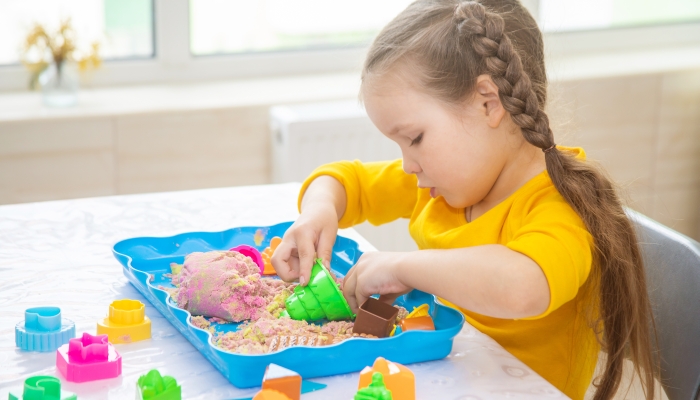
This post may contain affiliate links; please see our terms of use for details.
- Sensory play includes any activities that engage a child’s five senses.
- Sensory play ideas do not have to be complicated or expensive to help kids explore learning through their senses.
- Sensory play activities help your child learn even when they are fun and unstructured.
Children learn through play, and sensory activities help young kids develop their cognition, language, and social skills.
Children engage in sensory play naturally, often without knowing it. Daily activities like riding a bike, blowing bubbles, jumping in a ball pit, writing with sidewalk chalk, or making cookies all engage your child in sensory learning.
However, you can enhance your child’s sensory engagement with fun sensory materials, toys, and activities.
Take a look at our guide to hands-on activities for preschool sensory development for some fantastic fun ideas you can try at home.
Activity 1. Water Play
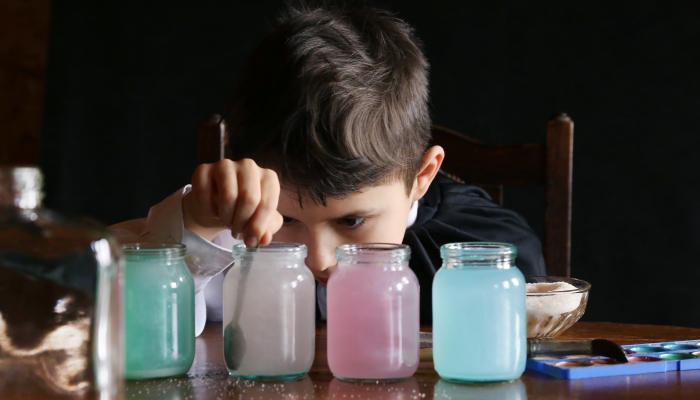
Playing with water is endlessly fun for children, but it can also have a calming effect while teaching them about physics and science along the way. Try this water activity:
You will need:
- Three clear containers, like glasses, for primary colors
- Three empty clear containers for mixing secondary colors
- Spoons
- Water
- Food coloring
How to play:
Start with clear water in your primary color containers. Add a few drops of one primary color to each container: red, yellow, or blue. Let your child describe how the color spreads in the water. Give them a spoon for mixing.
Next, have your child pour some red and yellow together in an empty container to make orange. Repeat with the other containers to mix yellow and blue and red and blue. Allow your child to mix the colors and add more food coloring.
For a variation on this sensory activity, dip strips of paper into the different colors to watch how the colored water moves up the paper and observe what happens to the color.
This sensory activity develops fine motor skills, like pouring and squeezing, as well as skills like color recognition and learning about the color spectrum.
Activity 2. Sensory Bins
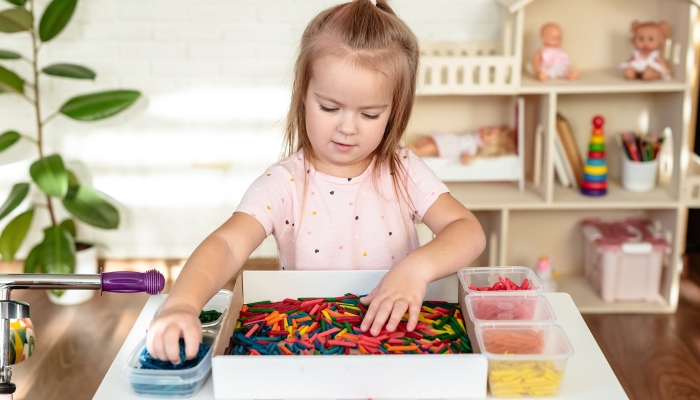
Sensory bins are an easy and inexpensive way to give your child a tactile sensory play experience for lots of hands-on fun. There are many variations on this fun activity, and younger kids will return to their sensory bin again and again.
You Will Need:
- Box, bin, or container with solid sides. You can use anything from a shoe box to a bucket, but large, clear, plastic storage bins often work well.
- Sensory filler like sand, uncooked pasta, colored uncooked rice, kinetic sand, dry beans, Easter grass, cotton balls, water, or cloud dough.
- Kid-friendly tools, like scoops, spoons, popsicle sticks, or measuring cups.
- Sensory table or other flat surface that your child can comfortably reach and that is easy to clean.
How To Play:
The first step of sensory bin play is to create your bin. Give it a base with your chosen filler and then add interesting items for your child to explore. Check out these sensory bin ideas:
| Aquarium Bin |
|
| Dinosaur Bin |
|
| Alphabet Bin |
|
| Sand and Shell Bin |
|
Sensory bins give your child a fun sensory activity they can self-direct. They enhance their learning through unstructured play while they have a blast exploring texture, shape, color, and sound. However, sensory bins can also pose choking hazards, so be sure your child’s play is always supervised.
Activity 3. Sensory Walk
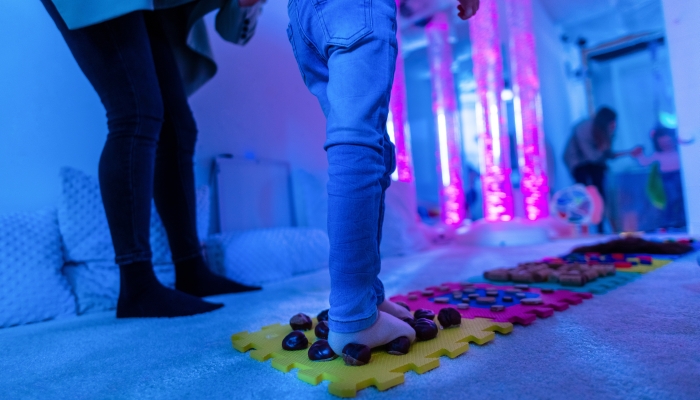
Children learn so much about the world through tactile activities. While they may play using their hands a lot, let them explore how things feel on their feet. Try this activity for some fun sensory exploration, best done outside!
You will need:
- Several bins or containers that your child can step into, one for each texture you are using.
- Different sensory items to put in each bin, for example, craft poms poms, smooth pebbles, sand, feathers, cotton balls, play dough, grass, leaves, fabric scraps, and anything that would feel interesting on their feet.
How To Play:
Set up your bins in a path. Ask your child to step into each container barefoot and describe how it feels. If you use water or shaving cream, be careful of slipping and have a towel available.
Ask your child whether each element feels different on their hands compared to their feet.
For another version of this activity, have your child step across leftover bubble wrap to pop the bubbles. It’s fun and loud, and it never fails to delight.
This activity helps your child with balance, stimulates the proprioceptive and vestibular systems, and also helps with language development.
Activity 4. Shaving Cream Alphabet
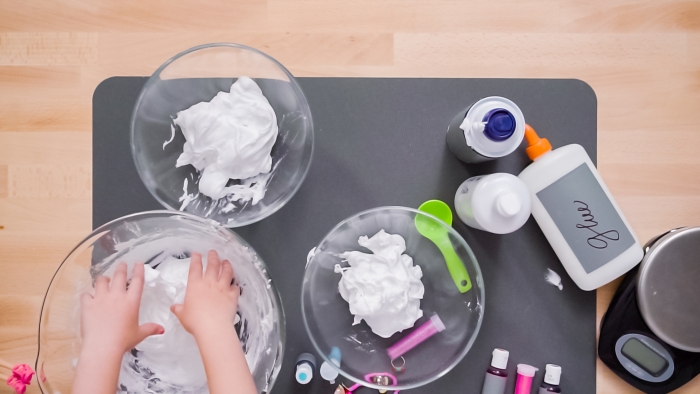
Shaving cream is a great and inexpensive sensory tool. Always keep some handy, but beware, it’s definitely not mess-free!
This is a fun way for children to learn the alphabet. We did this with my sons, who have dyslexia. Dyslexic children benefit from associating touch with letter formation.
You Will Need:
- Can of shaving cream
- Tabletop or flat surface with a wipe-clean tablecloth
- Smock for your child (optional)
- Spatula for smoothing out the cream
How to Play:
There are two different ways to play, depending on your child’s abilities.
Spray a layer of shaving foam onto your surface. Ask your child to write their name and letters or draw in the cream using their finger. Let your child explore using the spatula to make a smooth surface.
Or:
Give your child the shaving cream if they’re able to press the top. Ask them to write their name in big foam letters on your surface.
The small movements of tracing the letters help with fine motor skills and letter recognition as well as stimulating the sense of touch. Large movements writing with the can help with gross motor skills.
Activity 5. Make Your Own Musical Instruments
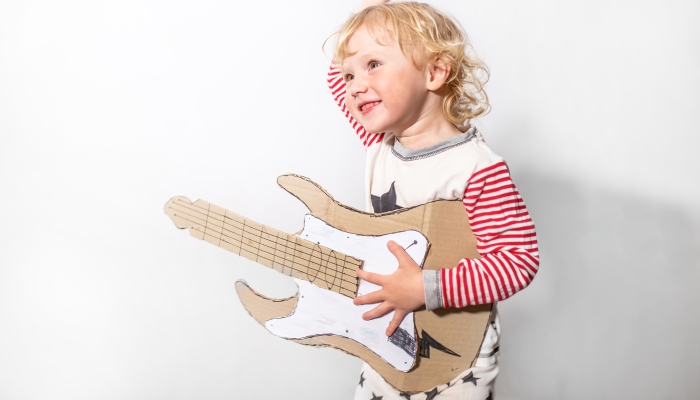
Music and sound are essential to sensory learning. While musical toys can be fun, showing your child how to experiment with sounds themselves is easy and fun.
You Will Need:
For the sound tube:
- Cardboard paper towel tubes
- Duct tape
- Dry pasta, beans, rice, or lentils
For the box guitar:
- Empty rectangular cardboard box, i.e. shoe box or tissue box
- Rubber bands
- Cardboard tube
How To Play:
Sound Tube: Make a sound tube by sealing one end of a cardboard tube with duct tape. Add your chosen filler and seal the other end.
Fill a few tubes with different materials and talk about the difference in their sounds.
Box Guitar: Make a box guitar by first cutting a hole in the lid of a shoe box. Tape the lid to the box. Stretch rubber bands across the hole. Tape a cardboard tube to one end to create the guitar neck.
Talk about the different sounds the rubber bands make and why.
This is a brilliant early STEM activity as well as a way to stimulate your child’s interest in sound.
Essential Components of Sensory Play

Sensory play includes activities that engage the five senses: sight, sound, smell, taste, and touch. These activities aid cognitive development, language skills, social skills, and motor skill development.
According to experts at the Cleveland Clinic11. Cleveland Clinic. What Is Sensory Play? The Benefits for Your Child and Sensory Play Ideas. Cleveland Clinic. 2022. https://health.clevelandclinic.org/benefits-of-sensory-play-ideas , sensory play also addresses two other sensory systems:
- Proprioception refers to our awareness of our body in space and how body parts function together.
- Our vestibular sense helps us to maintain balance.
Sensory play helps with cognition and socialization, and many children also find sensory stimulation calming. It helps children learn to self-soothe, self-regulate, and process their emotions.
Basic Sensory Materials
Creating great sensory play experiences for your preschooler doesn’t have to be complicated or expensive. Many toys, gadgets, and art materials are marketed as “sensory,” but you don’t need to invest lots of money in products with this label. You probably already have many items that will make excellent components for sensory play.
Almost any household item can help create an amazing sensory experience. However, only use items that are age-appropriate, safe, and non-toxic in case your preschooler ingests them.
Small, tactile sensory items, like pebbles and dry rice, can pose a choking risk, so always supervise your child’s play.
| Natural sensory elements |
|
| Manufactured sensory elements |
|
| Items you already have around the house |
|
| Protective gear |
|
Create Sensory Spaces
You’ve probably seen sensory rooms filled with expensive equipment and would love to create the ultimate sensory space for your child, but do they really need to be big and expensive?
Fortunately, you can create a small sensory space on a budget that your child will love just as much!
- Indoor Spaces: Create a calming sensory corner. Choose a space in your living room or child’s bedroom. Cover the floor with textured and colorful foam tiles and include sensory light toys for added interest. Add a bean bag and pillows along with stuffed animals for comfort. Complete the space by adding sensory sequin fabric, textured wall decals, or chalkboard paint to the walls. Leave items out that your child likes to play with, like fabric swatches, musical instruments, or tactile toys.
- Outdoor Spaces: All of your child’s senses are engaged when they’re outside playing in nature. Outdoor sensory play helps develop your child’s gross motor, language, and social skills. It also gets them interested in the natural world, which leads to engagement with STEM activities.
- 🤗 DESIGNED FOR KIDS & BABIES: MioTetto foam play mat is a great solution for creating an optimal, safe, learning and playing space for your little angel. Soft, colorful, and super easy to assemble, these play mat tiles for kids are a great solution for the nursery or playroom.
- 😴 SAFE: Crafted from high-quality EVA foam, our mat is designed with your child’s safety in mind. It’s free from harmful chemicals like lead, BPA and phthalates, meeting the highest safety standards including ASTM F963-2023, 16 CFR PART 1500, CPSIA, and California Proposition 65. The REACH certification ensures it’s free from over 200 substances of very high concern, making it perfect for activities like tummy time and crawling.
- 🧐 EASY TO ASSEMBLE: Our 12 x 12-inch foam floor jigsaws match perfectly so you can combine them to create a customized area with a unique look. You can choose between the 18 (2 for free) piece set that includes 27 borders, or the 36-piece set with 54 borders. These puzzle floor mats cover a maximum of 16 sq ft, and 36 sq ft respectively. Perfect for 50×50 playpen
- 😊 CLEAN & SOFT ENVIRONMENT: The EVA foam interlocking tiles have a 0.4-inch thickness that keeps kids safe and comfy, preventing accidents by isolating them from hard floors. This gym mat surface is waterproof and durable, as well as super easy to clean so you can always make sure that your kids are playing in a proper environment.
- 🌷【0.5 CM Large Sequins for Better Tactile & Visual Stimulation】The special tactile stimulation sequin fabric, the sequins are bigger and more obvious, which is more suitable for kids’ tactile and visual tracking exercise.
- 🌷【Fun Sensory Wall Graffiti Fabric, Available Anywhere, Reusable】Pleasant finger sensory tactile stimulation, just touch and flip the sequins to draw different objects or letters, it is a sensory graffiti wall cloth that children like very much. It can be used on different places such as floor, wall, desk,without worrying about soiling clothes and walls.
- 🌷【Sensory Game Toys for Sensory Room Tactile Therapy or Visual Tracking Exercise】Fixed the sequin fabric to the wall or board with glue, it can be turned into a big graffiti sensory wall or sensory board decoraitions, suitable for children with autism, anxiety Sensory therapy,calming toys for autistic children.
- 🌷【Some sequins are on the edge of cutting and will fall off. no need to worry. If you are not satisfied, you can return.】We will try our best to give you more beautiful and durable products.There will be extra base fabrics at both ends for securing.
- Squigz will stick to virtually any flat surface
- Leaves no residue
- Push them together then pop them apart
- Always up for playful experimentation and defying gravity
Encourage messy play outdoors (where it’s easier to clean up!) with these ideas:
- Create a mud kitchen
- Draw with sidewalk chalk
- Create a water and sand table
- Collect seasonal items on a nature walk in your local park, like autumn leaves and pine cones
- Play with bubbles
Integrating Sensory Play in Daily Learning
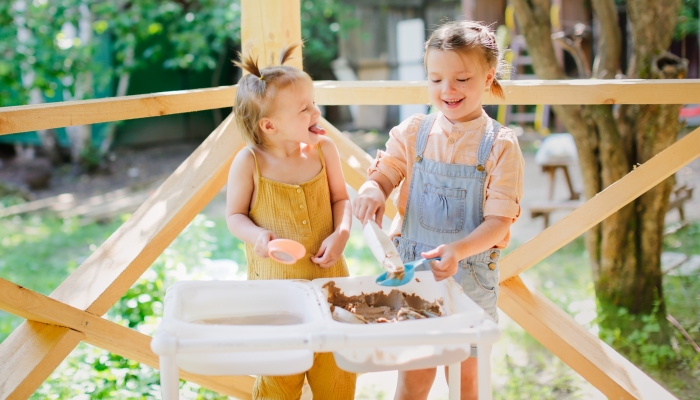
One of the great things about sensory play is that your child naturally engages with it all of the time.
Sensory learning happens when your child pets the family cat, pours water from a cup into the bathtub, makes a den out of a cardboard box, or turns their night light on and off to hear the click of the button.
For children with special needs, sensory play is important for teaching self-regulation, improving focus, and practicing fine and gross motor skills.
Although your child will organically engage in sensory play, you can encourage their learning by incorporating sensory activities into your daily routines. For example:
| At mealtimes |
|
| At bathtime |
|
| At bedtime |
|
- 𝗧𝗵𝗲 𝗯𝗮𝗯𝘆 𝗿𝗲𝗴𝗶𝘀𝘁𝗿𝘆 𝗲𝘀𝘀𝗲𝗻𝘁𝗶𝗮𝗹: 𝖱𝖾𝗌𝗍 𝗂𝗌 𝗍𝗁𝖾 𝖺𝗅𝗅-𝗂𝗇-𝗈𝗇𝖾 𝗌𝗅𝖾𝖾𝗉 𝖽𝖾𝗏𝗂𝖼𝖾 𝗍𝗁𝖺𝗍 𝗍𝖾𝖺𝖼𝗁𝖾𝗌 𝗁𝖾𝖺𝗅𝗍𝗁𝗒 𝗌𝗅𝖾𝖾𝗉 𝗁𝖺𝖻𝗂𝗍𝗌 𝖺𝗇𝖽 𝖽𝖾𝗏𝖾𝗅𝗈𝗉𝗌 𝗂𝗇𝖽𝖾𝗉𝖾𝗇𝖽𝖾𝗇𝗍 𝗌𝗅𝖾𝖾𝗉 𝖺𝗍 𝖾𝗏𝖾𝗋𝗒 𝖺𝗀𝖾 𝖺𝗇𝖽 𝗌𝗍𝖺𝗀𝖾. 𝖥𝗋𝗈𝗆 𝗅𝗂𝗀𝗁𝗍 𝖺𝗇𝖽 𝗌𝗈𝗎𝗇𝖽 𝗉𝖺𝗂𝗋𝗂𝗇𝗀𝗌 𝗍𝗁𝖺𝗍 𝖻𝗎𝗂𝗅𝖽 𝗒𝗈𝗎𝗋 𝖻𝖺𝖻𝗒’𝗌 𝖿𝗂𝗋𝗌𝗍 𝗌𝗅𝖾𝖾𝗉 𝗋𝗈𝗎𝗍𝗂𝗇𝖾, 𝗍𝗈 𝗆𝗎𝗌𝗂𝖼 𝖺𝗇𝖽 𝗌𝗍𝗈𝗋𝗂𝖾𝗌 𝗍𝗁𝖺𝗍 𝗁𝖾𝗅𝗉 𝖻𝗂𝗀 𝗄𝗂𝖽𝗌 𝗐𝗂𝗇𝖽 𝖽𝗈𝗐𝗇 𝖺𝗍 𝗇𝗂𝗀𝗁𝗍, 𝖱𝖾𝗌𝗍 𝗁𝖾𝗅𝗉𝗌 𝗍𝗁𝖾 𝗐𝗁𝗈𝗅𝖾 𝖿𝖺𝗆𝗂𝗅𝗒 𝗌𝗅𝖾𝖾𝗉 𝖾𝖺𝗌𝗂𝖾𝗋.
- 𝗕𝘂𝗶𝗹𝗱 𝗵𝗲𝗮𝗹𝘁𝗵𝘆 𝘀𝗹𝗲𝗲𝗽 𝗵𝗮𝗯𝗶𝘁𝘀: 𝖢𝗋𝖾𝖺𝗍𝖾 𝗋𝗈𝗎𝗍𝗂𝗇𝖾𝗌 𝗍𝗁𝖺𝗍 𝗌𝗂𝗀𝗇𝖺𝗅 𝗌𝗅𝖾𝖾𝗉 𝖿𝗈𝗋 𝗅𝗂𝗍𝗍𝗅𝖾 𝗈𝗇𝖾𝗌. 𝖣𝗋𝖾𝖺𝗆𝗒 𝗅𝗂𝗀𝗁𝗍 𝖺𝗇𝖽 𝗆𝗎𝗌𝗂𝖼 𝗌𝗈𝗈𝗍𝗁𝖾𝗌 𝗍𝗁𝖾𝗆 𝖺𝗍 𝖻𝖾𝖽𝗍𝗂𝗆𝖾 𝖺𝗇𝖽 𝗄𝖾𝖾𝗉𝗌 𝗍𝗁𝖾𝗆 𝗌𝗅𝖾𝖾𝗉𝗂𝗇𝗀 𝗍𝗁𝗋𝗈𝗎𝗀𝗁 𝗍𝗁𝖾 𝗇𝗂𝗀𝗁𝗍.
- 𝗗𝗲𝘃𝗲𝗹𝗼𝗽 𝗜𝗻𝗱𝗲𝗽𝗲𝗻𝗱𝗲𝗻𝗰𝗲: 𝖢𝗎𝗌𝗍𝗈𝗆𝗂𝗓𝖾 𝗅𝗂𝗀𝗁𝗍 𝖺𝗇𝖽 𝗌𝗈𝗎𝗇𝖽 𝖼𝗈𝗆𝖻𝗂𝗇𝖺𝗍𝗂𝗈𝗇𝗌 𝖿𝗈𝗋 𝗌𝗂𝗀𝗇𝖺𝗅𝗌 𝗍𝗈 𝗄𝖾𝖾𝗉 𝗍𝗁𝖾𝗂𝗋 𝗋𝗈𝗎𝗍𝗂𝗇𝖾 𝗈𝗇 𝗍𝗋𝖺𝖼𝗄. 𝖢𝗎𝖾 𝗒𝗈𝗎𝗋 𝗅𝗂𝗍𝗍𝗅𝖾 𝗈𝗇𝖾𝗌 𝖿𝗈𝗋 𝗇𝖺𝗉𝗌 𝖺𝗇𝖽 𝖻𝖾𝖽𝗍𝗂𝗆𝖾 𝗐𝗂𝗍𝗁 𝖳𝗂𝗆𝖾-𝖿𝗈𝗋-𝖡𝖾𝖽 𝗈𝗋 𝗅𝖾𝗍 𝗒𝗈𝗎𝗋 𝖾𝖺𝗋𝗅𝗒 𝗋𝗂𝗌𝖾𝗋 𝗄𝗇𝗈𝗐 𝗐𝗁𝖾𝗇 𝗍𝗈 𝗌𝗍𝖺𝗒 𝗂𝗇 𝖻𝖾𝖽 𝖺𝗇𝖽 𝗐𝗁𝖾𝗇 𝗂𝗍’𝗌 𝗈𝗄 𝗍𝗈 𝗀𝖾𝗍 𝗎𝗉 𝗐𝗂𝗍𝗁 𝖳𝗂𝗆𝖾-𝗍𝗈-𝖱𝗂𝗌𝖾.
- 𝗖𝗼𝗻𝘁𝗿𝗼𝗹 𝘃𝗶𝗮 𝗮𝗽𝗽 𝗳𝗿𝗼𝗺 𝗮𝗻𝘆𝘄𝗵𝗲𝗿𝗲: 𝖳𝗁𝖾 𝖱𝖾𝗌𝗍 𝟤𝗇𝖽 𝗀𝖾𝗇 𝗂𝗌 𝖶𝗂-𝖥𝗂 𝖾𝗇𝖺𝖻𝗅𝖾𝖽. 𝖠𝖽𝗃𝗎𝗌𝗍 𝗌𝖾𝗍𝗍𝗂𝗇𝗀𝗌 𝖺𝗇𝖽 𝗌𝖾𝗍 𝗌𝖼𝗁𝖾𝖽𝗎𝗅𝖾𝗌 𝗋𝖾𝗆𝗈𝗍𝖾𝗅𝗒 𝗐𝗂𝗍𝗁 𝗒𝗈𝗎𝗋 𝗌𝗆𝖺𝗋𝗍𝗉𝗁𝗈𝗇𝖾 𝗈𝗋 𝖼𝗈𝗇𝗍𝗋𝗈𝗅 𝗏𝗈𝗅𝗎𝗆𝖾 𝖺𝗇𝖽 𝗇𝗂𝗀𝗁𝗍 𝗅𝗂𝗀𝗁𝗍 𝖻𝗒 𝗍𝗈𝗎𝖼𝗁 𝗐𝗂𝗍𝗁 𝖾𝖺𝗌𝗒 𝖺𝖼𝖼𝖾𝗌𝗌 𝖻𝗎𝗍𝗍𝗈𝗇𝗌 𝗈𝗇 𝗍𝗁𝖾 𝖽𝖾𝗏𝗂𝖼𝖾.
- Don’t be fooled by imitators! Sky Lite Evolve, with its patented nebula cloud technology and beautiful cobalt blue stars, is a one-of-a-kind experience you won’t find anywhere else. Experience a symphony of dazzling, reinvented nebula cloud hues that blend effortlessly, creating a breathtaking display unrivaled by other galaxy projectors. This isn’t just a visual feast, it’s a portal to serene relaxation and immersive gaming experiences that truly sets a new standard.
- Relax or fall asleep to the peaceful drifting nebula clouds, pierced by ultra-sharp laser stars that stand out brilliantly against the drifting nebula clouds – the perfect night light, bedroom decoration, and beyond.
- If you’ve carved out a space to get away in your home, or need to, the Sky Lite Evolve is the element that will shift your atmosphere from relaxing to a full-on utopia.
- Full 360-degree rotation is made possible thanks to the new spherical design. With coverage of up to 900 square feet, the possibilities for relaxation, entertaining, and world-building are endless.
References
- Cleveland Clinic. (2022, March 18). What Is Sensory Play? The Benefits for Your Child and Sensory Play Ideas. Cleveland Clinic. https://health.clevelandclinic.org/benefits-of-sensory-play-ideas
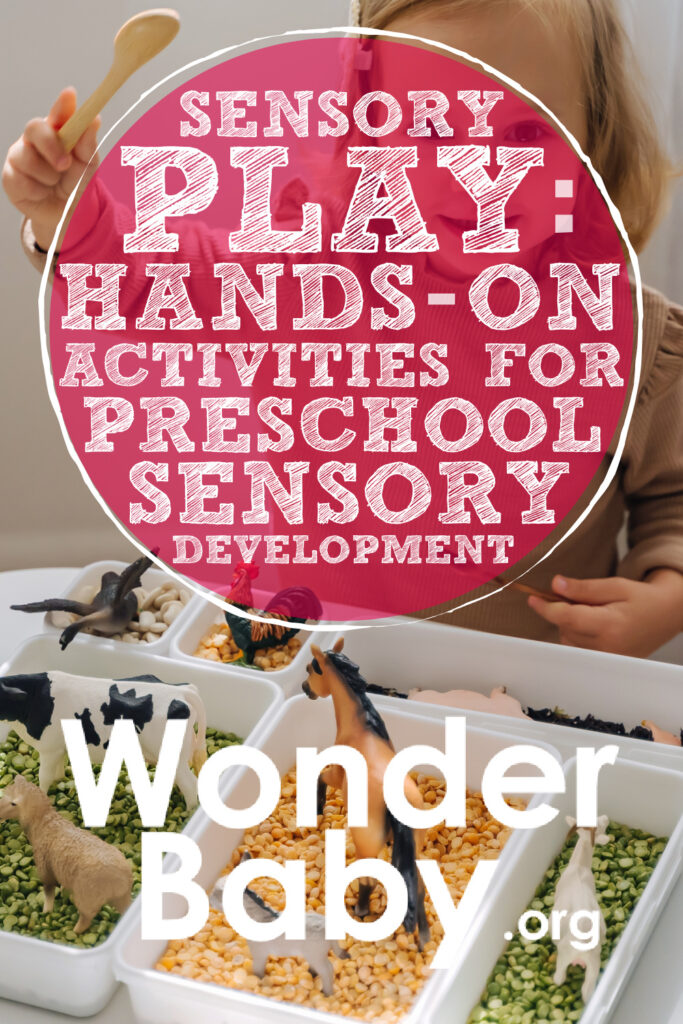
Related Posts

Sensory Activities
5 Sand Play Activities to Encourage Fine Motor Development
Sensory bin, at the beach, or in a sandpit? Try these sand play activities to help toddlers and preschoolers develop their fine motor skills.

Sensory Activities
5 Edible Sensory Play Ideas
Check out our favorite edible sensory play activities to engage children's senses, boost their development, and provide hours of fun.

Sensory Activities
How to Make Unpoppable Bubbles
Discover the secret to making unpoppable bubbles with this easy guide. You only need three ingredients!




